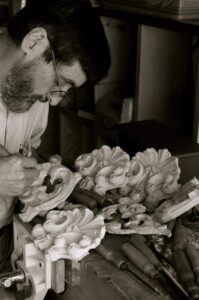Wood – think about it.
Yielding
Wood bends and flexes, stretches and then compresses and twists. It does this when it grows, and also when we work it. I look for this as I work it because these characteristics vary my work and from one piece of wood to another I find changes; even within the species. Moreover, they affect the tools I use, the cutting edges and much more. I write these things so you will be aware that developing the senses enables us to become ready to shift and change tool, direction, angle, pressure and even the bevel or tooth to the task in certain cases. Response is critical to the senses whereas reaction often stems from our being unresponsive in the course of our working. I say all this to preface the fact that wood yields.
Absorbing
All woods are different. Not two woods I know of respond to the chisel and the plane or the saw the same way. I still find that a wonderful dimension. I know the texture and content of cherry, the evenness of its structure and substance. The loveliness of its amber colour and the way it responds so willingly to my hands. Walnut too, I know very well. It’s irritating dust from the machines and yet with the plane and the saw no issues at all. Its brittleness reminds me not to be so hard on things in my own life. To move more carefully. If I do, something quite beautiful happens to the wood and to me.
Accomadating
Woods we might consider lesser woods are lovely to me. Spruce, firs, pines and such that fall in the range we call conifers are really lovely in their varying degrees of texture and density. And of maple, oak and mesquite, ashe-juniper, ash, cedar elm, poplar and many other woods, I have feelings about these too. Imagine a life so enriched by such simple things. I know other woods we call exotics; like ebony and rosewood, cocobolo, pink ivory, greenheart, lignum vitae and several others like meranti, jujube , makore, jelutong and different mahoganies too.
Forgiving
It isn’t so much that wood does those things that I said that I respect wood, but the fact that wood grows and then yields in so many ways. This yielding comes in manifold ways; one I see is that wood gives up its being for the work I have in hand, hence a tree yields so many board-feet or cubic metres or cubic-feet of wood. The second type I see is that it yields in the sense that it gives way to the tools I use and the cutting edges that sever its fibres. The third way is unknown to most. This is the yielding that absorbs the impressions of life in the home and offices, factories and workplaces of different kinds, perhaps more of old than of now. A dent and scratch waxed and polished over. Scuff marks and indents from a ballpoint pen that never would have happened with a quill or a fountain pen. And what of pollution too? Plane trees in London absorb the effects of human life and clean the air those of London breath. Trees yield to record forest fires and droughts in every growth cycle recorded in rings by season; volcano eruptions and such. What an amazing vessel this thing called tree is.




To All handtool enthusiast,
I suggest you take a look at this link, its amazing what a skilled craftsman can do with a few sharp tools.
http://greenwood-carving.blogspot.com/2011/09/fantastic-old-swedish-woodworking-film.html
Excellent insight and a beautiful treatise on the life of wood. Life is like wood sometimes, we are shaped and smoothed for specific tasks, take a few dents and scratches and with a little polishing move on.